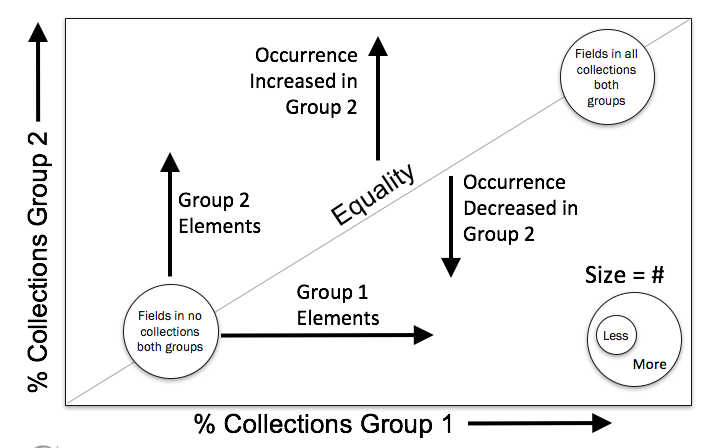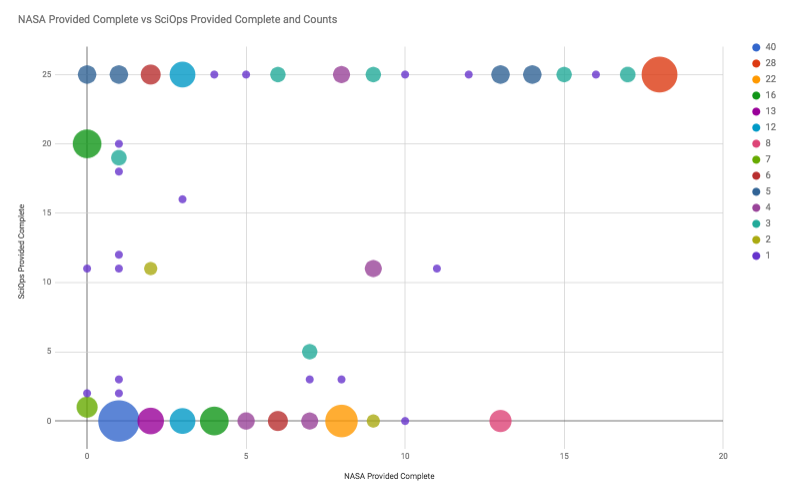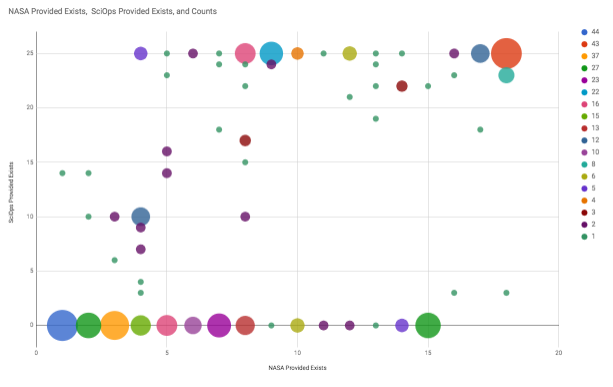Overview
The CMR includes metadata that originate in three dialects: DIF, ECHO, and ISO. The largest portion of CMR collection records are in the SciOps collection, and are inserted into the CMR in DIF format. These are referred to here as the SciOps collection. The second largest portion of metadata for NASA collections originate from ECHO and are inserted into the CMR in ECHO format. These are referred to here as the NASA collection. A third group of metadata in the CMR originate from other agencies around the world and are generally either in DIF or possibly in ISO. These are referred to as the Other collection.
The DIF and ECHO dialects were originally developed to facilitate discovery of collections in the Global Change Master Directory or ECHO. The content of these “discovery” dialects is translated into the ISO dialects that are the eventual target for CMR. This translation is generally done without augmentation, so the content does not change very much.
Metadata providers have a choice about which metadata dialect(s) they use to submit metadata to the CMR. We compared the SciOps and NASA collections to understand how does this choice effects the metadata content.
Data Selection
The SciOps data collection includes over 13,000 metadata records from nearly 2,000 different sources, most outside of NASA. Over 1700 of these sources have less than ten metadata records. Assuming that there is variation in metadata creation techniques for these providers, this is likely not a homogeneous collection. We identified 25 providers that have collections with one hundred or more records and examined those as separate collections. Table 1 below shows the 18 NASA provider and 25 SciOps Providers considered in this evaluation, as well as the record count for each provider.
Table 1. Collections and record counts
Collection | Organization | Count |
| Collection | Organization | Count |
ASF | NASA | 161 |
| COLUMBIA | SCIOPS | 214 |
CDDIS | NASA | 38 |
| DOE | SCIOPS | 202 |
GES_DISC | NASA | 1044 |
| DOIUSGSGD | SCIOPS | 128 |
GHRC | NASA | 361 |
| DOIUSGSPUBS | SCIOPS | 105 |
LAADS | NASA | 130 |
| DOIUSGSSESC | SCIOPS | 207 |
LANCEAMSR2 | NASA | 6 |
| IAI-DIS | SCIOPS | 116 |
LANCEMODIS | NASA | 154 |
| ICSU | SCIOPS | 112 |
LARC | NASA | 406 |
| IOBIS | SCIOPS | 295 |
LARC_ASDC | NASA | 606 |
| JP | SCIOPS | 112 |
LPDAAC_ECS | NASA | 285 |
| KR | SCIOPS | 329 |
NSIDC_ECS | NASA | 223 |
| LTER | SCIOPS | 177 |
NSIDC_V0 | NASA | 784 |
| NSIDC | SCIOPS | 187 |
OB_DAAC | NASA | 132 |
| NZ | SCIOPS | 857 |
OMNIRT | NASA | 5 | UCAR | SCIOPS | 437 | |
ORNL_DAAC | NASA | 1216 | UEA | SCIOPS | 104 | |
PODAAC | NASA | 603 | UK | SCIOPS | 33 | |
SEDAC | NASA | 202 | UMD | SCIOPS | 169 | |
USGS_EROS | NSIDC | 11 | UNEPDEWA | SCIOPS | 373 | |
| ACADIS | SCIOPS | 393 | UNEPROAP | SCIOPS | 162 | |
| AR | SCIOPS | 142 | USAP | SCIOPS | 190 | |
| BCO-DMO | SCIOPS | 136 | USC | SCIOPS | 151 | |
| CN | SCIOPS | 134 |
Not Provided Values
The CMR team (NASA and SciOps) are in the difficult position of trying to make a coherent and useful metadata repository by collecting metadata from many organizations and projects that have different goals and needs. This presents a challenge as the CMR evolves and new requirements emerge. Metadata managers need to account for content that is not provided by the metadata providers. At the current time, this is between three and five percent of the content.
The solution for both NASA provided collections and SciOps provided collection is to add the string “Not provided” to expected fields that have no content. This clearly indicates that content is missing, except that tools that read the metadata or translate it must be aware of and consider this convention to get meaningful results. The tools we use for evaluating metadata completeness are agnostic to element and attribute values. Therefore the analysis presented below, which compares NASA Complete with SciOps Complete does not include metadata fields with a value of 'Not Provided'. Below are the fields with 'Not Provided' values that were excluded from NASA Complete with SciOps Complete evaluation
NASA Collections - Fields with ‘Not Provided' values
/gmi:acquisitionInformation/gmi:instrument/gmi:type
/gmd:identificationInfo/gmd:pointOfContact/gmd:organisationName
/gmd:identificationInfo/gmd:abstract
/gmd:identificationInfo/gmd:descriptiveKeywords/gmd:keyword
/gmd:identificationInfo/gmd:resourceConstraints/gmd:useLimitation
/gmd:contentInfo/gmd:processingLevelCode/gmd:code
/gmd:identificationInfo/gmd:pointOfContact/gmd:individualName
/gmi:acquisitionInformation/gmi:instrument/eos:sensor/eos:type
/gmd:contact/gmd:organisationName
/gmi:acquisitionInformation/gmi:platform/gmi:identifier/gmd:code
/gmd:contentInfo/gmd:dimension/gmd:otherProperty/gco:Record/eos:AdditionalAttributes/eos:AdditionalAttribute/eos:reference/eos:description
/gmd:identificationInfo/gmd:processingLevel/gmd:code
/gmi:acquisitionInformation/gmi:platform/gmi:description
/gmd:identificationInfo/gmd:status/gmd:MD_ProgressCode
Sciops Collection - Fields with ‘Not Provided' values
/gmd:identificationInfo/gmd:processingLevel/gmd:code
/gmd:identificationInfo/gmd:citation/gmd:edition
/gmi:acquisitionInformation/gmi:platform/gmi:description
/gmd:identificationInfo/gmd:descriptiveKeywords/gmd:keyword
/gmd:contentInfo/gmd:dimension/gmd:otherProperty/gco:Record/eos:AdditionalAttributes/eos:AdditionalAttribute/eos:reference/eos:description
/gmi:acquisitionInformation/gmi:instrument/gmi:type
/gmi:acquisitionInformation/gmi:platform/gmi:identifier/gmd:code
/gmd:identificationInfo/gmd:status/gmd:MD_ProgressCode
/gmd:contentInfo/gmd:processingLevelCode/gmd:code
/gmd:identificationInfo/gmd:citation/gmd:identifier/gmd:version
SciOps vs. NASA
This analysis compares item usage (elements and attributes) in the 18 NASA collection with the 25 SciOps collections. This evaluation identifies items which exist in collections as well as items that are complete in collections. In order for an item to exist in a collection it must be present in at least 1 metadata record included in the collection. In order for an item to be complete in a collection it must be present in all metadata records included in the collection.
Item usage for NASA collections and SciOps collections are shown below using bubble charts. The bubble chart interpretation graphic provides a schematic for interpreting the bubble plots.
Bubble Chart Interpretation
NASA Provided Complete vs SciOps Provided Complete
Chart 1 below compares provided item (elements and attributes) completeness in NASA Collections with SciOps collections. The X axis shows the number of NASA collections that are complete with respect to an item. The Y axis shows number of SciOps collections that are complete with respect to an metadata items. The bubble size shows the number of items included in the 2 collections.
The large red bubble in the upper right corner of the plot shows items that are complete is all 18 NASA collections and in all 25 SciOps collections. This bubble includes 28 items, as shown in the legend. The large blue bubble in the lower left corner of the plot shows the items that are complete in 1 NASA collection and in 0 SciOps collections. This bubble includes 40 items, as shown in the legend. The data for Chart 1 is accessible in Google Sheets. To view the data and bubble chart in Google Sheets click on the image.
Chart 1: NASA Provided Complete vs SciOps Provided Complete
Accessing the Chart
To access the data for this chart, click on the chart graphic above to view an interactive version in Google Sheets. The interactive version enables data identification for each bubble and includes a look up table for identifying the ISO items associated with the bubble. To access and use the interactive version:
- Click on the chart graphic above to view the chart in Google Sheets
- Hover over the bubbles with your mouse to identify the number of complete NASA collections and the number of complete SciOps collections associated with the bubble. The hover identification also shows the number of items (Counts) associated with each bubble.
- To the right of the chart is a lookup table for identifying the xpaths associated with each of the bubbles. To identify the xpaths associated with a bubble, match the NASA Provided Complete and SciOps Provided Complete values (from the bubble hover) with the values in the look up table.
Elements complete in all SciOps Collections or no SciOps Collections
The schematic diagram above indicates that in these visualizations bubbles congregate near the equality line for similar collections. Bubbles congregate near the axis if collections differ significantly. Note that this comparison clearly suggests significant differences between these collections. Eighty-seven of two hundred and sixty-two (87/262 = 33%) of the provided elements are complete in all SciOps collections (along top axis) and one hundred and twenty-eight (128/262 = 49%) are complete in none of the SciOps collections (along the bottom axis). This means that 82% of the elements are either complete or absent in the SciOps collections.
Elements in all NASA and SciOps Collections
Twenty-eight items (elements and attributes) are complete in all NASA and all SciOps Collections: See the All NASA and All SciOps filtered view to identify these elements.
Elements in all SciOps Collections and some NASA Collections
Fifty-nine items (elements and attributes) are complete in all SciOps collections and complete in a smaller number of NASA collections. See the All SciOps and Some NASA filtered view to identify these items.
Elements in some NASA Collections and No SciOps Other Collections
Two hundred and seventy-three items (elements and attributes) are complete in no SciOps collections and are complete in some number of NASA collections. See the Some NASA and No SciOps filtered view to identify these items.
NASA Provided Exist vs SciOps Provided Exist
Chart 2 below compares item existence in NASA Collections with SciOps collections. The X axis shows the number of NASA collections that include an item. The Y axis shows number of SciOps collections that include an item. The bubble size shows the number of items included in the 2 collections.
The large red bubble in the upper right corner of the plot shows the items (elements and attributes) that exist is all 18 NASA collections and in all 25 SciOps collections. This bubble includes 43 items, as shown in the legend. The large blue bubble in the lower left corner of the plot shows items that exist is 1 NASA collection and in 0 SciOps collections. This bubble includes 44 items, as shown in the legend. The data for Chart 2 is accessible in Google Sheets. To view the data and bubble chart in Google Sheets click on the image.
Chart 2: NASA Provided Exists vs SciOps Provided Exists
Accessing the Chart
To access the data for this chart, click on the chart graphic above to view an interactive version in Google Sheets. The interactive version enables data identification for each bubble and includes a look up table for identifying the ISO items (elements and attributes) associated with the bubble. To access and use the interactive version:
- Click on the chart graphic above to view the chart in Google Sheets
- Hover over the bubbles with your mouse to identify item existence in NASA collections and item existence in SciOps collections associated with the bubble. The hover identification also shows the number of items (Counts) associated with each bubble.
- To the right of the chart is a lookup table for identifying the xpaths associated with each of the bubbles. To identify the xpaths associated with a bubble, match the NASA Exists and SciOps Exists value pairs (from the bubble hover) with the value pairs in the look up table.
Other Filters
Elements or Attributes
To view just the elements, click here select the Elements or the Attributes filtered view from the toolbar.


